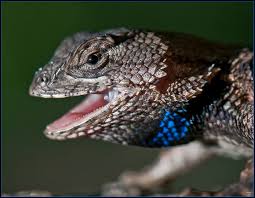We're open daily! View holiday hours
Science News
Beards!
November 17, 2013

By Molly Michelson
Attention! Beards may be cool, but they’re not just attractive.
Don’t take my word for it. According to NPR, psychologists at the University of New South Wales in Sydney found that women slightly preferred a heavy, 10-day stubble, (something like George Michael’s look during the Faith years), compared to a full beard or a clean-shaven face.
And humans are not the only ones. Penn State researchers have discovered that Eastern fence lizards, Sceloporus undulates, prefer their mates to be beard-free. I should specify: their female mates need to be beard-free. Male fence lizards have bright blue "badges" outlined in black on both sides of their throats and abdomens. In addition, many females also have this blue ornamentation, although it is less vibrant and covers a smaller area.
“Just as some human females have male-pattern facial hair, albeit less pronounced than in males, some female fence lizards display the typically-male blue markings,” says researcher Tracy Langkilde. "However, whereas in human females the masculine characteristics are less common within the population, in fence lizards, we see the opposite pattern: about three quarters of the females are so-called ‘bearded ladies,’ making masculinized females much more common than their counterparts with little or no blue ornamentation.”
Using a combination of field observations and laboratory manipulations, Langkilde and grad student Lindsey Swierk designed experiments to determine whether male lizards preferred the more-masculine bearded ladies or their beardless sisters. “We found that, although males do not say 'no' to bearded ladies, they clearly discriminate against blue-ornamented females, opting more often to court females without coloring,” Swierk says. “The question is why? Is it possible the males mistake the bearded ladies for fellow males? Or are bearded ladies somehow less fit and, therefore, less attractive to males?”
To answer this last question, the team members studied the differences between the reproductive output of bearded ladies and the less-common females without male-pattern coloring. They found that, compared to their beardless counterparts, bearded ladies laid clutches that weighed less. In addition, they laid their eggs about 13 days later in the mating season.
“As a result, females with less blue coloration may have an evolutionary advantage with regard to the fitness of their offspring,” says Langkilde. “This might explain why males tend to prefer them.”
Langkilde and Swierk hypothesize that although bearded ladies currently are more common in many fence-lizard populations, the evolutionary tide might be turning. “What we might be observing is a gradual trend toward more sexual dimorphism within this species,” Swierk saiys. Sexual dimorphism is defined as the difference in color, shape, size, or structure between males and females of the same species. Darwin and others have suggested that one of the major factors driving these differences is sexual selection – the theory that an animal chooses a member of the opposite sex based on some observable feature that signals good health and superior genes. “It is possible that, over the course of several generations, we will see the beardless lizards winning out over their bearded-lady sisters,” Langkilde adds.
But maybe it is the bearded ladies that have the advantage, Langkilde says. “Another possibility is that bearded ladies may benefit by having especially sexy sons.” The team’s previous research has shown that females prefer really blue males and so, “if these bearded ladies pass their vivid coloration on to their sons, this could give them an advantage by ensuring they have lots of grandchildren.”
So while not always considered attractive amongst Eastern fence lizards, beards may be at least advantageous, evolutionary-wise. This interesting research was published last week in Biology Letters.
Image: Wikimedia